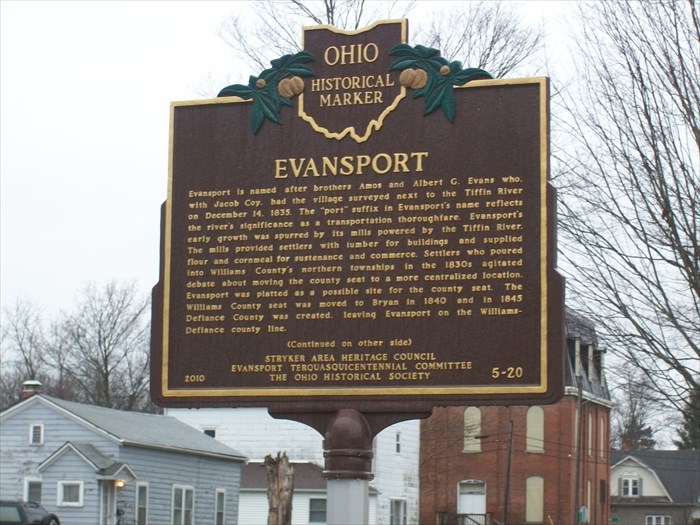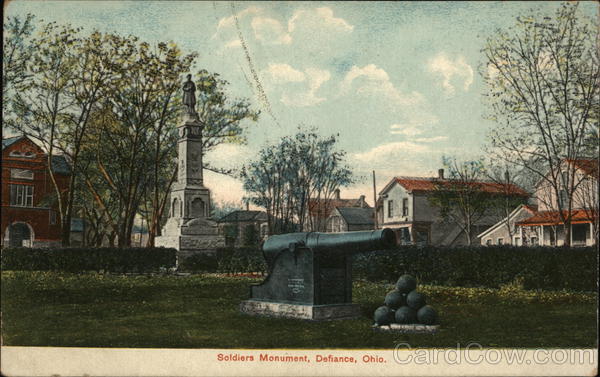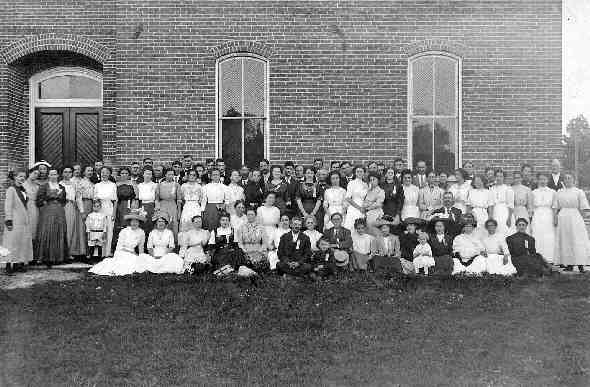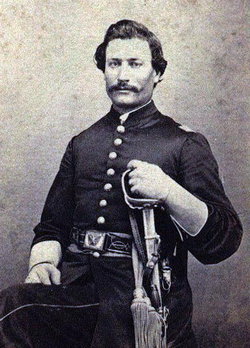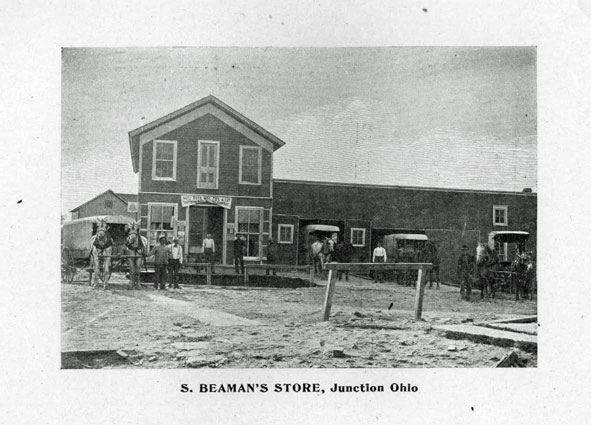For 50 years Clyde Elder has served and manged a store at Mark Center. Now still active (1960) with his son, Arnold, in the business known as "Elder and Son", he looks back over the years to explain his success in making large and extensive sales in a small town location.
Mr. Elder was born in 1885 on an 80 acre farm southwest of Mark Center (Defiance Co. Ohio). His father, Curtis Elder born in Pennsylvania, was a Civil War veteran who had moved to Fostoria and had about 1880 purchase land in Mark Twp. at the same time his friend, Valentine Lybarger, had bargained for land near Hicksville.
Clyde's mother, Elder's second wife, was Emma Crawford, daughter of Samuel Crawford. She had come from Spitzenburg, Germany, when she was 12 years old.
When a small boy, Clyde had attended District 8 School. The plank building was later replaced by one that stood until recent years. The family attended Mark Center Methodist Church. It was necessary for them to travel on mud roads in all kinds of weather.
"Sometime we walk to Sunday School and then home for dinner. Often we returned for services," Mr. Elder recalled, "I can remember", he said "when we had protractive meetings one winter and the minister decided that we would have a spelldown", as was often customary in those days. My brothers, sisters, and I were very surprised when we discovered that our mother could out spell them all. Her stiffest competitor had been Uncle Ike Haver.
Although Mr. Elder didn't dance much, he liked to watch the dancers. The "bowery" dance gave such an opportunity. He explained what such dance would be like.
"In the summertime, they would go to the woods and get poles which would then be laid on the ground, and clapboards placed across them. Other poles were stood on end around the edge and green boughs were placed over the top."
"Then, at night, the place was lighted with lanterns. There young and old of the neighborhood danced, sometime 12 sets at a time."
"I wish" said Mr. Elder, "young people of today could see the way those couples could dance. The men would dance jigs around the ladies, and they were really good."
I was a Methodist," explained Mr. Elder, "that was the reason I didn't dance much myself."
Mark Center was quite a place then with two stave mills, a railroad station, a store, and five saloons. It had earlier been moved from the center of the township at the junction of present route 2 and 18, and it was just begining to feel its importance as a community center.
"When I was growing up," remark Mr. Elder, "I was always interested in horse. All of the young men had horses and buggies, and each though that he had the best. The greatest sport was to prove it. Sometimes, it was not without accident. I had my wrist broken three times. Twice it was because of horses."
"If the word delinquent had been invented in those days, I for one, with my mad desire for horse racing, would have been called one," he chuckled.
"The fact is the Kentucky Derby for several years. I already have my receipt for my ticket this year. You have to apply in January," he added.
Timber men and stave mill workers, and money frequently crossed the counter in exchange for goods.
The business continued in the Hire family, and Harry Hire became owners.
In 1911, he built the present cement block two-story building. The upper floor was constructed for use as a apartment. It was here that the Elders lived for many after they became the store's owners.
Mr. Elder explained how they had kept up with the times and not suffered from a depression.
"Several years ago, I realized that one has to keep up with the times, so we built a feed mill.Later, when food supplement was used to feed livestock, we began to sell that."
Amish farmers, near the Mark Center community, needed a place where they could buy feed without driving long distance. It has been for their convenience that the Elders have carried the extra sideline.
"After my wife and I bought the store," he remarked, people used to come into town and sit in the seats that then lined the store. Sometime they bought nothing. They'd just sit there and visit the entire evening.
"There used to be spittoons all around the store. Although we'd empty them frequently, often our customers missed their mark, and it was our job to clean up. I used to think that if one could only bottle the order what a good disinfectant it would have made.
 "The first sale I made was pound of crackers for a dime. These I sold to Mr. Mark Slough. Our business was greatest on Saturday. It seemed that every. It seemed that every man that came to Mark Center bought three pounds of crackers for 25 cents.
"The first sale I made was pound of crackers for a dime. These I sold to Mr. Mark Slough. Our business was greatest on Saturday. It seemed that every. It seemed that every man that came to Mark Center bought three pounds of crackers for 25 cents.
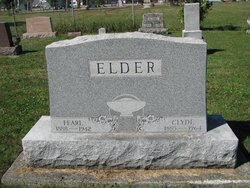
Although Mr. Elder didn't dance much, he liked to watch the dancers. The "bowery" dance gave such an opportunity. He explained what such dance would be like.
"In the summertime, they would go to the woods and get poles which would then be laid on the ground, and clapboards placed across them. Other poles were stood on end around the edge and green boughs were placed over the top."
"Then, at night, the place was lighted with lanterns. There young and old of the neighborhood danced, sometime 12 sets at a time."
"I wish" said Mr. Elder, "young people of today could see the way those couples could dance. The men would dance jigs around the ladies, and they were really good."
I was a Methodist," explained Mr. Elder, "that was the reason I didn't dance much myself."
Mark Center was quite a place then with two stave mills, a railroad station, a store, and five saloons. It had earlier been moved from the center of the township at the junction of present route 2 and 18, and it was just begining to feel its importance as a community center.
"When I was growing up," remark Mr. Elder, "I was always interested in horse. All of the young men had horses and buggies, and each though that he had the best. The greatest sport was to prove it. Sometimes, it was not without accident. I had my wrist broken three times. Twice it was because of horses."
"If the word delinquent had been invented in those days, I for one, with my mad desire for horse racing, would have been called one," he chuckled.
"The fact is the Kentucky Derby for several years. I already have my receipt for my ticket this year. You have to apply in January," he added.
Timber men and stave mill workers, and money frequently crossed the counter in exchange for goods.
The business continued in the Hire family, and Harry Hire became owners.
In 1911, he built the present cement block two-story building. The upper floor was constructed for use as a apartment. It was here that the Elders lived for many after they became the store's owners.
Mr. Elder explained how they had kept up with the times and not suffered from a depression.
"Several years ago, I realized that one has to keep up with the times, so we built a feed mill.Later, when food supplement was used to feed livestock, we began to sell that."
Amish farmers, near the Mark Center community, needed a place where they could buy feed without driving long distance. It has been for their convenience that the Elders have carried the extra sideline.
"After my wife and I bought the store," he remarked, people used to come into town and sit in the seats that then lined the store. Sometime they bought nothing. They'd just sit there and visit the entire evening.
"There used to be spittoons all around the store. Although we'd empty them frequently, often our customers missed their mark, and it was our job to clean up. I used to think that if one could only bottle the order what a good disinfectant it would have made.
 "The first sale I made was pound of crackers for a dime. These I sold to Mr. Mark Slough. Our business was greatest on Saturday. It seemed that every. It seemed that every man that came to Mark Center bought three pounds of crackers for 25 cents.
"The first sale I made was pound of crackers for a dime. These I sold to Mr. Mark Slough. Our business was greatest on Saturday. It seemed that every. It seemed that every man that came to Mark Center bought three pounds of crackers for 25 cents.
Footnote Clyde Elder pass away 30 Oct. 1964, and buried at Sherwood Cemetery, Defiance Co., Ohio.

